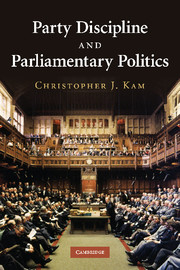Book contents
- Frontmatter
- Contents
- List of figures
- List of tables
- Acknowledgements
- 1 Introduction
- 2 A model of intra-party politics
- 3 Patterns of backbench dissent in four Westminster parliamentary systems, 1945–2005
- 4 Policy preferences and backbench dissent in Great Britain and Canada
- 5 Dissent, constituency service, and the personal vote in Great Britain and New Zealand
- 6 The cost of dissent to the party
- 7 Demotion and dissent in the Canadian Liberal Party, 1991–1997
- 8 Discipline and dissent in the Australian Coalition, 1996–1998
- 9 Career trajectories, socialization, and backbench dissent in the British House of Commons
- 10 Conclusion
- Appendix 1 Comparative statics and proofs
- Appendix 2 Content and construction of ideological scales
- Appendix 3 Sampling and coding of media dissent and discipline
- Appendix 4 Demotion and the parliamentary careers of Canadian MPs
- References
- Index
7 - Demotion and dissent in the Canadian Liberal Party, 1991–1997
Published online by Cambridge University Press: 03 July 2009
- Frontmatter
- Contents
- List of figures
- List of tables
- Acknowledgements
- 1 Introduction
- 2 A model of intra-party politics
- 3 Patterns of backbench dissent in four Westminster parliamentary systems, 1945–2005
- 4 Policy preferences and backbench dissent in Great Britain and Canada
- 5 Dissent, constituency service, and the personal vote in Great Britain and New Zealand
- 6 The cost of dissent to the party
- 7 Demotion and dissent in the Canadian Liberal Party, 1991–1997
- 8 Discipline and dissent in the Australian Coalition, 1996–1998
- 9 Career trajectories, socialization, and backbench dissent in the British House of Commons
- 10 Conclusion
- Appendix 1 Comparative statics and proofs
- Appendix 2 Content and construction of ideological scales
- Appendix 3 Sampling and coding of media dissent and discipline
- Appendix 4 Demotion and the parliamentary careers of Canadian MPs
- References
- Index
Summary
Those who have not witnessed the making of a government have reason to be happier than those who have. It is a thoroughly unpleasant and discreditable business in which merit is disregarded, loyal service is without value, influence is the most important factor and geography and religion are important supplementary considerations.
The Borden Ministry was composed under standard conditions, and was not, therefore, nearly as able, honest, or as industrious an administrative aggregation as could have been had from the material available … There were some broken hearts – in one instance, literally. In others, philosophy came to the rescue, but the pills were large and the swallowing was bitter.
Paul BilkeyIntroduction
One of the main predictions of the LEADS model is that, all else equal, dissent increases as office benefits became less available within the party. The aggregate-level results of Chapter 3 comport with this theoretical proposition, showing a negative relationship between the frequency and extent of dissent in the party and the relative size of the party's front bench. This chapter provides the individual-level analogue to this aggregate result. At the start of the 1993–7 Parliament, Jean Chrétien, the new Liberal prime minister, withheld government appointments from a large number of incumbent MPs. These demoted incumbents then went on to cast more dissenting votes in the Parliament than their colleagues.
- Type
- Chapter
- Information
- Party Discipline and Parliamentary Politics , pp. 150 - 168Publisher: Cambridge University PressPrint publication year: 2009



